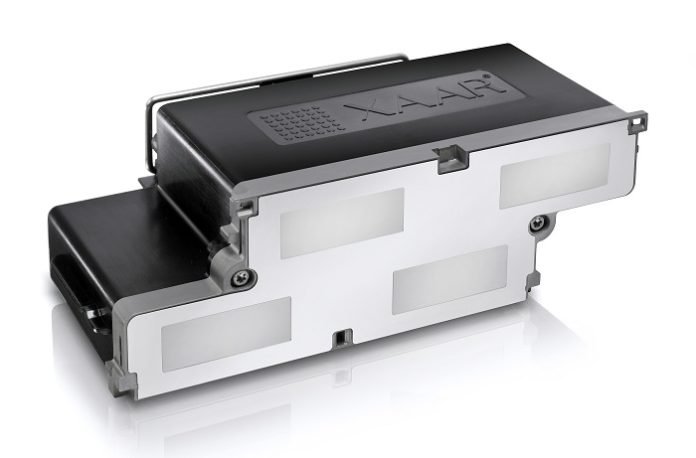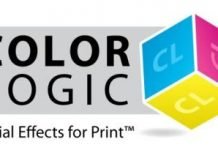In many respects, the printhead is the heart of an inkjet printer, directly responsible for placing each individual drop of ink on the substrate.
Inkjet printheads are marvels of modern engineering, able to precisely place thousands of drops of ink of differing sizes exactly where needed. There are several approaches to designing printheads but by far the most common for wide-format inkjet is drop-on-demand (DoD) piezo.
Essentially, the printhead contains an ink chamber, with a piezo electric actuator, made of a material such as Lead Zirconium Titanium (PZT). When an external electrical charge
is applied to PZT, it changes shape, forcing a drop of ink from the ink chamber and out through the nozzle. This design is suitable for a wide range of different ink types, including aqueous, solvent and UVcurable inks.
The only real alternative is thermal technology, which is used by HP for its latex printers and Canon for its ImagePrograf series. This involves heating the ink within the ink chamber, until it vaporizes, creating a bubble which forces a drop of ink through the nozzle. The technique is only really suitable for water-based inks, although HP has had considerable success in expanding the range of applications through its latex inks, which are water based and suitable for outdoor signage, as well as some textile applications.
So far we have seen how both the piezo and thermal printheads create enough pressure to force some ink through the nozzle, but this is only half the story. That pressure has to be cut off immediately, which draws some of the ink back into the nozzle. This cuts off the ink supply, halting the ink drop’s formation and inevitably, as the ink snaps back to the nozzle, it can splash the nozzle plate. The stray ink can ultimately lead to blocked nozzles and failed printheads.
Binary versus grayscale
The size of the individual ink drops directly affects overall output quality. In general, small drops produce good definition and high resolution and are good for text, while large droplets can cover large areas quickly and are good for printing large flat areas. Many
printers, particularly the bigger, faster flatbeds, take a binary approach with every drop being the same size because this is faster.
The alternative is to vary the size of the ink drops, a technique usually known as grayscale printing. There are a number of advantages to this. Firstly, mixing bigger and smaller dots makes it easier to deal with gradients and slight tonal shifts, such as in a skyscape or skin tones. It can also lead to reduced ink consumption, partly because some of the dots are quite small, but also because it is easier to get smoother gradients with four colors without
needing additional colors.
There are three basic approaches, albeit with several variations. The first is to actually fire different drop sizes, for example by varying the electrical power used to generate the drops. The second is to fire a very heavy drop of ink, which will stretch out as it flies through the air and break apart into larger and smaller droplets. Typically, many
printheads use a combination of approaches. The third alternative is known as multi-pulsing and involves quickly firing two drops of ink that then merge into a single larger drop, usually in flight before they hit the substrate.
Drop on demand
Many vendors have turned to Micro Electro Mechanical Systems (MEMs) because this technology offers a cost effective way of designing complex parts. Essentially, the system is
formed on a silicon or glass substrate. It is not the easiest technique and requires highly advanced micronscale fabrication technologies.
Companies using MEMs technology include Konica Minolta, which has a number of printheads such as the KM1024, widely used in large-format printers. There is a
faster version, the 1024i, which is suitable for UV and solvent inks. It has a high-performance heater built into the head, which makes it easier to handle high viscosity inks. It has a native drop size of 13 picoliters but can produce up to eight levels of grayscale. Resolution is 360 dpi.
Dimatix, which is now part of Fujifilm, makes a number of printheads, including the Q-class that are used in a number of wide format printers. There are 70 variations with different drop sizes from 10 to 200 picoliters in both binary and grayscale versions. The heads are
mounted into frames that have either two or four heads to allow up to 1024 nozzles.
Ricoh also produces printheads suitable for use in wide format digital printing and has just announced a new printhead—the MH5220. This has four rows of 320 nozzles for a total of 1280 nozzles and 1200 dpi resolution. It can jet multiple drop sizes from 2.5 to 9 picoliters by merging the drops in flight.
Xaar also uses MEMs for its Xaar 1003 series heads, which are suitable for use with UV and solvent ink. These printheads come with a new nozzle plate protection feature called
the XaarGuard designed to limit damage to the printheads, still a big cause of head failure.
Xaar’s latest printhead is the Xaar 5601, designed to handle aqueous fluids such as dye sublimation inks found in wide format textile printers. The 5601 series has 1200 nozzles per inch, with a native drop size of just 3 picoliters. However, this can be combined with eight grayscale levels to produce an apparent resolution of around 2440 dpi.
Both series use Xaar’s TF technology, which stands for Through Flow. Essentially, this means that the ink is re-circulated through the printhead past the back of each nozzle, helping to reduce the possibility of air and debris in the ink clogging the nozzles.
Epson has developed its Precision Core printhead, based on its thin film piezo technology, which is found in all of its wide format printers. The basic principle is that the thinner the piezo film the more it can flex, which in turn gives more precise control over the way that it
pushes the ink through the nozzle. As with most modern printheads, the PrecisionCore heads are based on MEMs technology.
Printer integration
While it is true that there are only a few companies making printheads, and that many printers in a given class will be using the same heads, there may still be considerable
differences between the printers and their performance. Most printhead vendors produce different variations of their heads, which can be tweaked to meet the demands of the printer developer.
In addition, the ink developers will work with the printhead manufacturers to test and tune both the way the heads are implemented and the formulation of the inks to get the best performance. This means testing what effect the ink will have on the heads, ensuring for example that the ink does not react with the coating on the nozzle plate or the adhesive bonding different parts of the head together. This testing also looks for the optimum viscosity of the ink, which will directly affect how the ink drops are formed, which might
mean heating the inks and ensuring that the head can cope with that temperature.
In most cases, the printhead manufacturer will also develop the drive electronics and waveforms necessary to fire the ink through the heads. However, many printer vendors prefer to develop their own waveforms as this directly affects the way the ink drops are formed and the overall performance of the ink with the heads.
Maintenance
Finally, it is worth pointing out the importance of good maintenance. The biggest single cause of printhead failures is blocked nozzles, which can mostly be avoided by regularly cleaning the heads. A few minutes spent at the beginning and end of each shift wiping the nozzles clean should ensure that printheads last several years, minimizing printer down time and saving money. In any case, it is best to ensure that the printer warranty includes
replacement of at least one printhead per year.
















